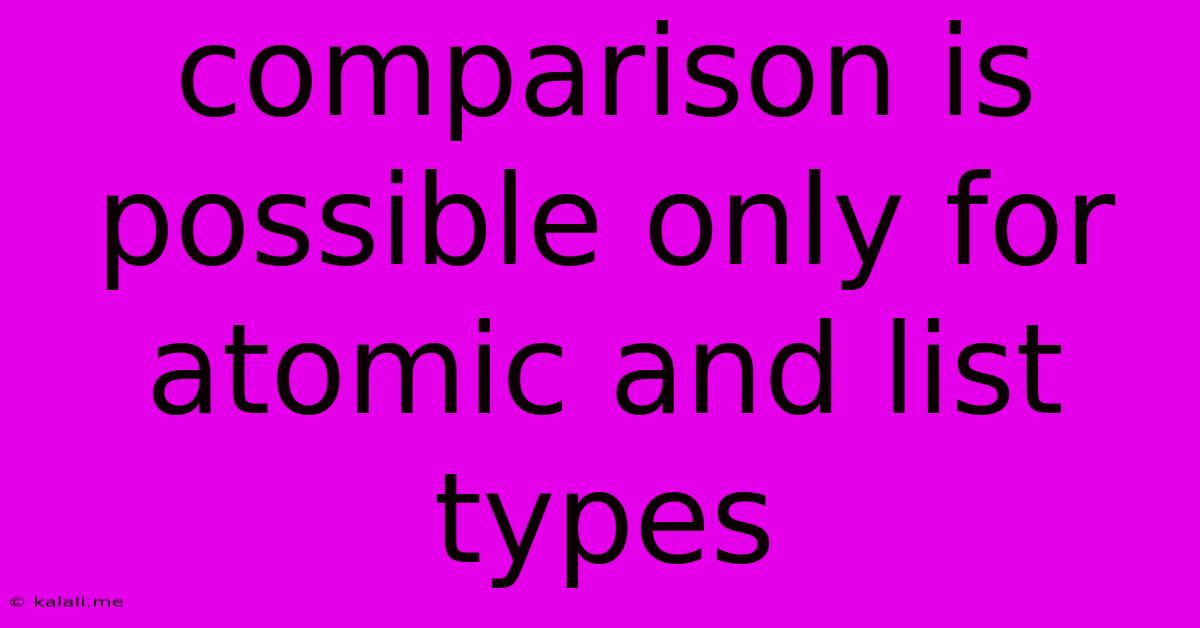Comparison Is Possible Only For Atomic And List Types
Kalali
May 30, 2025 · 3 min read

Table of Contents
Comparison is Possible Only for Atomic and List Types: A Deep Dive into Data Structures and Comparisons
Meta Description: This article explores the intricacies of data comparison in programming, focusing on why comparisons are fundamentally limited to atomic and list types. We'll delve into the reasons behind this limitation and examine the implications for developers.
In the realm of programming, comparing data is a fundamental operation. Whether you're sorting arrays, searching for specific values, or implementing conditional logic, the ability to compare data structures is crucial. However, this capability isn't universally applicable across all data types. This article will clarify why comparison is fundamentally possible only for atomic and list types, shedding light on the underlying principles and practical consequences.
Understanding Atomic Types
Atomic types, also known as primitive data types, represent single, indivisible values. Examples include:
- Integers (int): Whole numbers, such as -2, 0, 10, 1000.
- Floating-point numbers (float): Numbers with decimal points, such as 3.14, -2.5, 0.0.
- Characters (char): Single letters, symbols, or numbers represented as text characters.
- Booleans (bool): Representing truth values (true or false).
Comparison operations (e.g., ==, !=, <, >, <=, >=) are directly defined for atomic types. The computer can easily compare the numerical or textual representation of these values to determine their relative order or equality.
List Types and Their Comparability
List types, also known as arrays or sequences, are collections of elements. These elements can be of various data types, including other lists or nested structures. The comparison of list types typically focuses on:
- Element-wise comparison: Lists are compared element by element. If all corresponding elements are equal, the lists are considered equal. Inequality is determined by the first unequal element pair.
- Lexicographical ordering: For lists of comparable elements, lexicographical ordering is used (similar to dictionary ordering). This means comparisons are made based on the order of elements within the lists.
The ability to compare list types relies on the comparability of their constituent elements. If a list contains elements that are not comparable (e.g., complex objects without defined comparison methods), then a direct comparison of the entire list is often not possible or may lead to unpredictable results. This limitation is fundamentally tied to the need for a defined ordering or equality check for the individual elements within the list.
Why Complex Data Structures Pose Challenges
Complex data structures, such as trees, graphs, or custom objects, often lack a straightforward way to define a total ordering or equality. The inherent complexity of their structure makes simple element-by-element comparison insufficient or even meaningless. For instance, comparing two trees based on their node values alone might fail to capture structural differences. Therefore, comparing such data structures requires more sophisticated approaches, typically involving custom comparison functions or algorithms tailored to the specific data structure's characteristics. These approaches often involve recursive traversal or other computationally intensive methods.
Practical Implications for Developers
Understanding the limitations of comparison is crucial for writing efficient and correct code. When working with complex data structures, you may need to implement custom comparison logic. This could involve:
- Defining comparison methods: For custom objects, creating methods that define how objects should be compared (
__eq__,__lt__, etc., in Python) is essential. - Using specialized algorithms: Algorithms like graph isomorphism testing might be necessary for comparing complex structures like graphs.
- Focusing on relevant attributes: Instead of comparing the entirety of a complex object, you might choose to compare only specific, relevant attributes.
Ignoring these limitations can lead to unexpected behavior, incorrect results, and potentially even program crashes.
In conclusion, while atomic types readily support standard comparison operations, the comparability of data structures extends primarily to list types, provided their elements are also comparable. For more intricate data structures, developers must devise custom comparison strategies, underscoring the importance of understanding the fundamental nature of data comparison in programming.
Latest Posts
Latest Posts
-
How Did Dumbledore And Rab Know About The Horcrux Place
May 31, 2025
-
Does The Sun Amplify Radio Waves
May 31, 2025
-
Show Grants For All Users In Mysql
May 31, 2025
-
How To Make Soda Flat Instantly
May 31, 2025
-
How To Enable The User In Sql Server
May 31, 2025
Related Post
Thank you for visiting our website which covers about Comparison Is Possible Only For Atomic And List Types . We hope the information provided has been useful to you. Feel free to contact us if you have any questions or need further assistance. See you next time and don't miss to bookmark.